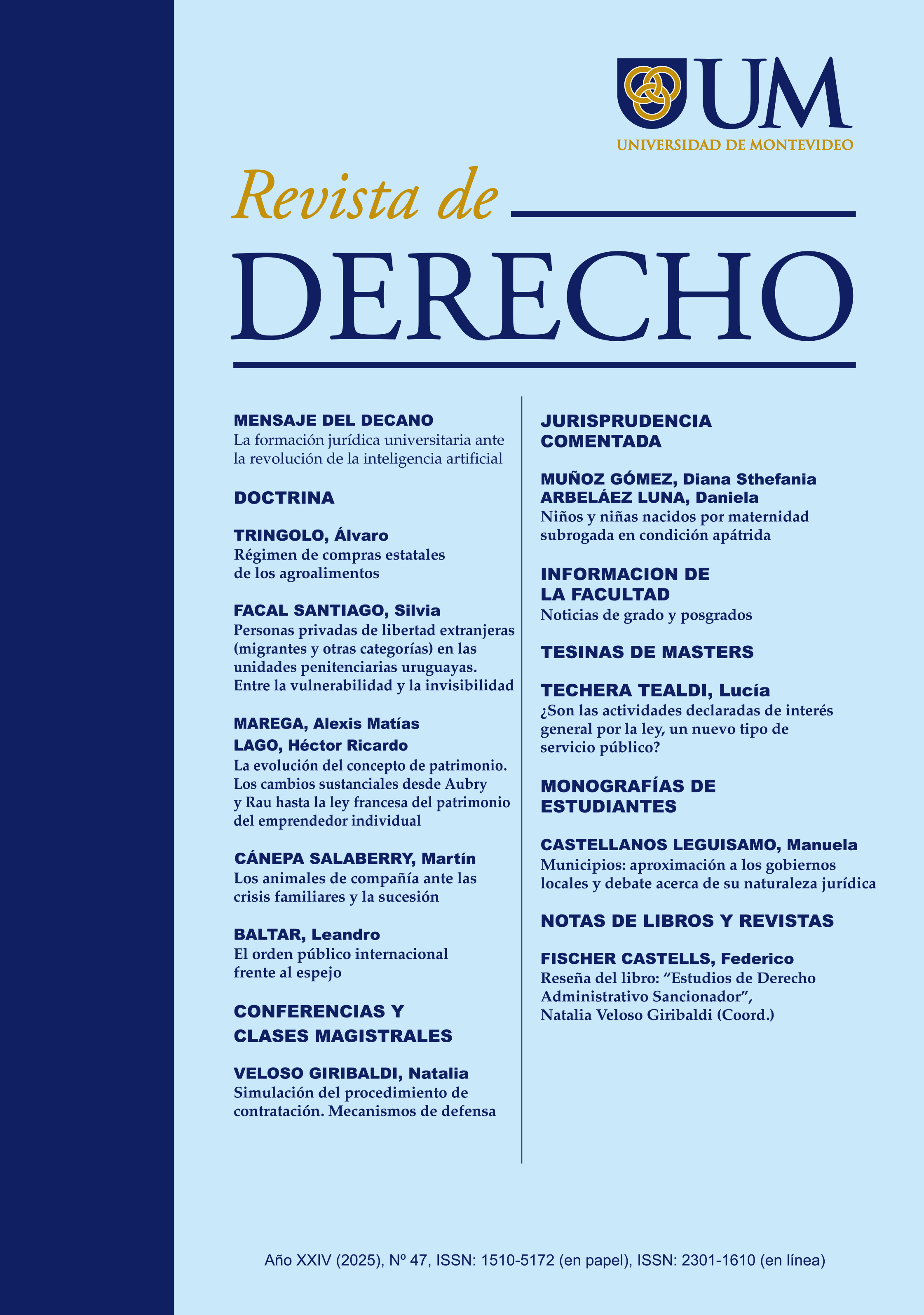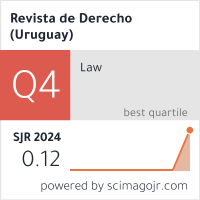The Evolution of the Concept of Net Worth
The Substantial Changes from Aubry and Rau to the French Law on the Individual Entrepreneur's Assets
DOI:
https://doi.org/10.47274/DERUM/47.3Keywords:
Net worth, Assets, Entrepreneur, Limited liability, Assets divisionAbstract
This paper aims to analyze the evolution of the concept of net worth from the classical theory of Aubry and Rau to recent legislative developments in French law which introduces the figure of the Individual Entrepreneur. Through a comparative methodology, the legal theories on net worth are reviewed, particularly the possibility of dividing assets without the need to create a new legal entity. The research focuses on Argentine, Spanish, Portuguese, and French regulations, highlighting the solutions each country has implemented to limit the liability of individual entrepreneurs. The demonstrated hypothesis is that it is possible to protect the personal assets of entrepreneurs without resorting to the creation of a legal entity, as the new French legislation does which breaks with the classical notion of a single and indivisible net worth.
Downloads
References
Alegría, H. (2022). “Importante novedad en el Derecho francés: el empresario individual con responsabilidad limitada (titular de dos patrimonios) Ley 2022-172.” La Ley F.
Álvarez, O. (2001). El concepto de patrimonio en Roma y los efectos de su incorporación en el Código Civil Argentino, ED 193.
Aubry, Ch. Rau, Ch. (1917). Cours de droit civil français. 5ª ed. (Vol. 6). Marchal et Billard.
Bamadé, A. (22 de junio, 2022) Le statut de l'emtrepreneur individuel: régles générales et condition. Le droit dans tous ses etats http://aurelienbamde.com/2022/06/18/le-statut-de-lentrepreneur-individuel-regles-generales-et-conditions/ .
Bonfante, P. (2002). Instituciones de derecho romano. 5 ed. Reus.
Borda, G. A. (1999). Tratado de derecho civil: Parte general. (Vol. 2). Abeledo-Perrot.
Cazorla, L. (2013). El Emprendedor y la Ley de Emprendedores. El Blog de Luis Cazorla http://luiscazorla.com/2013/09/a-vueltas-con-el-emprendedor-y-la-ley-de-emprendedores/ .
Cicu, A. (1948). La divisione creditaria. Giufré Editore.
Cinotti, L. (2022). Jhiering y su "espíritu del derecho romano”: lectura de un joven estudioso. Roma Tre Law Review.
Clermont, T. (2022) EIRL: suppression du statut depuis le 16 février 2022. Le Coin des Entrepreneurs. http://www.lecoindesentrepreneurs.fr/suppression-statut-eirl/#:~:text=Tr%C3%A8s%20peu%20de%20cr%C3%A9ateurs%20d,individuel%20le%2015%20mai%202022 .
Deppeler, N. (2005) Cuando se fuerzan la lógica y el derecho: Sobre la posibilidad del fraccionamiento sistemático del patrimonio. La Ley Suplemento Especial Sociedades ante la IGJ.
Enneccerus, L. Tratado de derecho civil. (Vol.1). Bosch, 1976.
Gago García, A. (2023) El emprendedor de Responsabilidad Limitada. [Tesis Trabajo fin de Grado, Universidad de Oviedo], 2023. E-Archivo. https://hdl.handle.net/10651/69370
Gore, F. (1977). Droit des affaires. Montchrestien.
Llambías, J. (1970). Tratado de Derecho Civil, parte general. Abeledo Perrot.
Marega, A. M., Maggio, R. H. y Lago, H. R. (2020). Sociedades por Acciones Simplificadas (SAS). El impacto de las SAS en “startups” y empresas familiares. Practica Integral Córdoba ERREPAR XIV. p. 1.095
Marega, A. M. y Palud, N. (2022). Ley Concursal y Código Penal: una tensa relación. ED 298(276).
Martín Azcano, E. M. (2011). El patrimonio protegido de las personas con discapacidad: Aspectos civiles. 1ª ed. La Ley, temas. La Ley.
Menjucq, M. (2022). Loi en faveur de l’activité professionnelle indépendante: la deuxiéme mort d’Aubry et Rau. Revue des procédures collectives, 1.
Mouta Mendes, F. (2024). Estabelecimento individual de responsabilidade limitada (EIRL). Sociedades Comerciais.
Olivera, D. (2023). Perdió estado parlamentario un proyecto de ley que pretendía llevar a todo el país la destrucción de las SAS que tuvo lugar en la ciudad de Buenos Aires. iProUP. http://www.iproup.com/economia-digital/38652-sociedades-emprendedores-las-sas-estan-a-salvo
Orgaz, A. (1948). Estudios de Derecho Civil. TEA.
Piaggi de Vanossi, A. I. (1997). Estudios sobre la sociedad unipersonal. Depalma.
Planiol, M. y Ripert, G. (2003). Tratado elemental de derecho civil. Cárdenas Velasco.
Plastara, G. (1903). La notion juridique du patrimoine. Rousseau et cie.
Poracchia, D. y Stoffel, J. N. (2022). Panorama sur le Nouveau satut d’entrepreneur individual. Bulletin Joly Sociétés, 9, 52-73
Ramírez, A. H. (2020). SAS. Sociedad por Acciones Simplificada. Astrea.
Revet, T. (2022). La désubjectivation du patrimoine. Lei n 2022-172 du 14 février 2022 en faveur de l’activité professionelle indepéndante. Recueil Dalloz, 9, 469.
Rivera, J. C. (2003). El fraccionamiento del patrimonio. Estudios de derecho civil obligaciones y contratos: Libro homenaje a Fernando Hinestrosa, 40 años de rectoría 1963-2003. (Vol.3). Universidad Externado de Colombia.
Rivera, J. C. “Las sociedades como instrumento para el fraccionamiento del patrimonio” en La Ley Suplemento Especial Sociedades Comerciales, Diciembre (2004): 117.
Rivera, J. C.. Instituciones de derecho civil: Parte general, 4ª ed., Buenos Aires, Abeledo Perrot, 2007.
Rivera, J. C. y Crovi, L. D. (2018). Derecho Civil parte General. Aires, Abeledo Perrot.
Von Tuhr, A. (1946). Derecho Civil - Teoría general del Derecho Civil Alemán: Trad. Totp Ravá, Marcial Pons.
























 This work is under a
This work is under a 